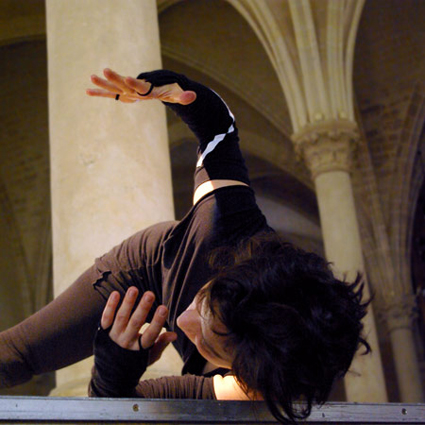Data noise & the limits of dance
Keith Gallasch, Myriam Gourfink & Kaspar Toeplitz, Breathing Monster

Myriam Gourfink, Breathing Monster
photo Nicolas Chaussy
Myriam Gourfink, Breathing Monster
After the discussion, debate and some rancour (see crikey.com) aroused by Myriam Gourfink and Kaspar Toeplitz’s Breathing Monster in ISEA2013 as part of Performance Space’s Switched On program, I thought it best to write plainly about the performance in order to make clear what it actually looked and felt like and possibly meant.
In Breathing Monster, French dancer and choreographic researcher Myriam Gourfink travels from one end of a platform [fluorescent lights at each end] to the other in two discrete moves, each comprising low, extremely slow turns—delicately balanced and predicated on two or more points of the body (hand, knee, foot, elbow) being temporarily in touch with the floor. Anxiety about imminent collapse passes, replaced by pleasure in the quiet beauty of seamless micro-movement pitched against bassist Kaspar Toeplitz’s spatially epic live score—built live from “’data noise’ generated through the minimal gestures of the dancer—creating an intermeshed monster of movement and sound” (program note).
In this 50-minute performance Gourfink takes 25 minutes to reach resting point midway along the platform before venturing on again, her body only occasionally revealing the fine muscular tremors that speak of stress. It’s not an easy performance to totally commit to, but there is the sense of overall flow (as one audience member suggested it would be fascinating to see the movement sped up on film, likely to reveal Gourfink as propelled like tumbleweed) and, in an intimate staging, the opportunity to take in the minutiae of the mechanics of a body shifting not unit by unit but as a totality—as a foot touches down, a hand turns slightly, an arm arcs away from the forward movement, a leg extends, toes push up. Shapes classical and unusual form and dissolve.
If you’ve experienced Matthew Day’s more immediately arresting work you’ll see a kinship with Gourfink’s performance in which our sense of time is equally suspended, all attention focused on the remarkable capacity of the body to enter strange states of being. If Day vibrates in his circular trajectories, Gourfink oscillates cyclically between stasis and perpetual motion on her linear journey. With Day there’s a dramatic sense of evolution, with Gourfink the mood is near meditative. However, our contemplation in the Sydney Performance is challenged by Toeplitz’s Cell Block-rattling live score. There’s no obvious one-to-one correlation between movement and sound, the music has its own character, from the opening rumble through to swelling organ-like tones, metallic waves, siren-like keenings, blips, decelerating glides and, in the final stage, wild bass flurries, a chilling high buzz (the dancer’s body presumably at its most stressed) and then a slow, deep, windy descent into silence long after Gourfink has ceased moving, as nerves and muscles finally come to rest.
Some nonsensical reviewing, with no eye to detail or motivation, has judged Breathing Monster in the same terms as it did the performances of the Nederlands Dans Theatre, visiting at the same time as Gourfink. These artists’ respective creations are of very different orders, Gourfink’s offering not only a thing of beauty in itself, if taxingly minimal for some audiences, but movement that speaks of investigation and potential for dance more broadly—as does Matthew Day’s more theatrical assaying of the body at the outer limits of dance.
Breathing Monster’s being programmed in data-mad ISEA2013 makes some kind of sense, at least rhetorically. It’s not at all clear how Toeplitz’s computer is registering the dancer’s “minimal gestures” as “data-noise” and treating them as a score for improvisation. Had the data come directly from a wired-up Gourfink the notion of data flow might been convincing but, without a program note explaining Toepltiz’s process, Breathing Monster manifested as a quite indeterminant creature. The artist on her website puts it this way:
“This breathing monster is about stillness and the powerful presence of the sound: the apparent stillness of the dancer whose microscopic movements are based on the intense activity of her deep-breathing, and the sheer weight of the sounds produced by the bass as transformed—in real time—by the computer, and also disturbed by the data-noise created by the dancers minimal gestures.”
It would appear then, in the absence of wiring or cameras, that the term “data-noise” is at best metaphorical. In an ISEA in which much movement was generated interactively between audiences and technology, here was a work by a dance artist and a musician ‘interacting’ quite conventionally, if with powerful physicality and musicality.






